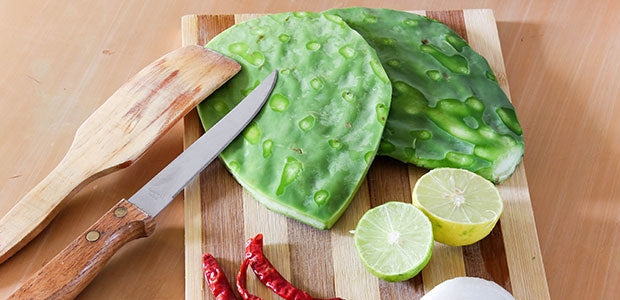By Véronique Cousineau, nd, rhn
In the kitchen, you have to know how to dare! This is what you are offered with the discovery of the cactus, the new supervision of the hour. Learn everything about the cactus including its origin, its preparation and its benefits. Maybe you also want to add a little to your menu?
The Nopal cactus
The cactus grows in semi-arid climates, even desert. It is therefore the populations of these places that naturally established it in their kitchen. Latin America is one of the world's regions that consumes the most cacti, followed by Australia and Africa. Being so located in Mexican food custom, it even appears on the country's flag!
The Nopal cactus is the most used for culinary purposes. It is harvested for its delicious red fruits and young shoots, also known as snowshoes. They are so called since they are, in fact, flattened stems of oval shape, recalling the appearance of the lawyer.
Cooking with cactus
In Mexican grocery stores, you can find fresh nopal leaves that will be used to make juice or water. Cactus juice is very nutritious and is full of minerals. In the same way as coconut water, cactus water can easily replace electrolyte drinks since it is naturally remineralizing and rehydrating. You can also grill the whole leaves (provided of course to remove the thorns!) Or even boil them. Some even make cactus racket jam!
In a natural food store or in conventional grocery store, we will rather find the cactus in the alley of the canned. The canned nopal leaf or Nopalitos is ready to cook, the thorns having already been withdrawn. Nopalitos make excellent salads, use very well in accompaniment vegetables and perfectly enhance an omelet with green vegetables.
Therapeutic properties
Like any over -greed, the cactus can be used for therapeutic purposes. There are among its interesting properties:
- Good source of carotenoid: a type of antioxidant capable of offering immune defenses;
- Good vitamin source: especially vitamins A, B and C;
- Antiviral properties: prevents the spread of herpes and influenza viruses;
- Good source of fiber: can relieve constipation and facilitate the detoxification of the colon;
- Anti-inflammatory effect: can decrease certain markers of inflammation;
- Fight against the "day after watch": decreases the symptoms of nausea and dehydration associated with alcohol abuse;
- Soothes ulcers and colitis: its gelatinous content can relieve gastric ulcers and significantly reduce intestinal inflammation;
- Fresh and soothing: its gelatinous content can be applied to the skin to relieve injury and burns, in the same way as aloe vera;
- Fighting Metabolic syndrome: significantly reduces plaque formation in the arteries;
- Balances cholesterol: some preliminary studies have shown that consumption of cactus rackets, when combined with a healthy diet, significantly reduces the rate of bad cholesterol;
- Stabilizes type 2 diabetes: Some Mexican studies have shown that consumption of cacti can decrease blood sugar by 45%. Cooking is however necessary to release this property.
In short, the cactus sows the curiosity of nutrition researchers and in the coming years, we will continue to learn more about its healing and therapeutic properties. In the meantime, it is better to gradually integrate the cactus into your diet, because its fiber -rich content can cause changes in the stool.
This new supervision will be increasingly available in stores and you can get it La Boite à Grains, in order to test it and add to your menu.
Véronique Cousineau
Naturopath, rhn


